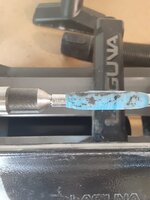Hey Penturners,
I'm fairly new to making pens, and made about 20 so far. I've done fairly well with no real issues. Recently, I have been having an issue with turning one of the ends to the bushing. It's always the left side, and it seems as though the chisel gets pulled downward thus cutting a gouge in the work. I use a round carbide tip chisel from rockler. Im using a very light touch when I get this close to the bushing and this close to finishing turning. I'm able to repair it with ca glue, but I would like to know what is causing this issue so I can avoid it in the future. Any suggestions will be greatly appreciated.
I'm fairly new to making pens, and made about 20 so far. I've done fairly well with no real issues. Recently, I have been having an issue with turning one of the ends to the bushing. It's always the left side, and it seems as though the chisel gets pulled downward thus cutting a gouge in the work. I use a round carbide tip chisel from rockler. Im using a very light touch when I get this close to the bushing and this close to finishing turning. I'm able to repair it with ca glue, but I would like to know what is causing this issue so I can avoid it in the future. Any suggestions will be greatly appreciated.

